published quarterly by the university of borås, sweden
vol. 24 no. 4, December, 2019
Introduction. The research area related to the public sphere and public libraries is home to disparate themes and methods. Fundamental conceptual differences exist despite calls for more focused research programmes. The purpose of this study is to clarify the research foundations of the field in order to chart a productive path forward.
Method. This in-depth literature review collected 120 works related to the public sphere and public libraries. The works were comprehensively identified in key journals, conferences, web searches, library collections, and databases.
Analysis. The literature was systematically described using qualitative content analysis. Results are presented qualitatively and quantitatively. Research design and research foundations were coded according to eight categories: 1) methodology, 2) data collection methods, 3) data analysis methods, 4) evidentiary basis, 5) resulting knowledge, 6) ontology, 7) epistemology, and 8) paradigm. Before coding, the frame was pilot-tested to ensure validity and reliability.
Results. There is a tendency toward qualitative methods, descriptive knowledge, and a reliance on other literature as an evidentiary basis. Idealist ontologies, interpretivist epistemologies, and constructionist paradigms are prevalent.
Conclusions. A combinatory approach following a constructionist, social science realist, positivist paradigm sequence may produce more focused research programmes in the future.
The public sphere as it relates to public libraries is said to form a distinct research area within library and information science literature. As evidenced by previous literature reviews, this relatively broad, interdisciplinary, and abstract research field collocates topics often considered separately. Topics in this area are said to include public library politics, social capital, civic culture in libraries, and public library history.
There have been several attempts to synthesize and define this research area. For example, Widdersheim (2016) defines the area according to two topical categories: 1) literature that explores how libraries serve as public sphere infrastructure, and 2) literature that explores how public libraries are a public sphere issue. This typology coincides with the governance-legitimation-commons framework proposed in Widdersheim and Koizumi (2015a, 2016a) and Widdersheim (2015). Within the two categories—library-as-infrastructure and library-as-issue—Widdersheim (2016) identifies n=64 relevant works. The review (perhaps) clarifies the public sphere concept, but the review also identifies conceptual ambiguities.
In their literature review, R. A. Audunson et al. (2018) attempt to define the research area according to methods and themes. The review identifies n=20 works within the research area. In terms of methods, the authors, distinguish empirical from theoretical studies. Empirical methods include interviews, surveys, participant observation, and document analysis/qualitative content analysis. By contrast, theoretical articles analyse Habermas’s concept of the public sphere, apply Habermas in combination with other theories, propose new conceptual models, or review literature. R. A. Audunson et al. (2018) identify 5 main themes in the literature: 1) public libraries as meeting places/infrastructure of the public sphere, 2) digitization of public sphere as seen in public libraries, 3) history and roles of public libraries in the public sphere, 4) decline of the public sphere as seen in public libraries, 5) and theoretical perspectives in library and information science. In conclusion, R. A. Audunson et al. (2018) propose several areas for future research, including the literary public sphere in public libraries, public libraries and the digital public sphere, the intersection between the private sphere and public sphere, and additional cases that juxtapose public libraries in urban/rural and homogeneous/heterogeneous contexts. The proposed research directions suggest that further conceptual clarification is needed within the research area.
A recent literature review by Vårheim, Skare, and Lenstra (in press) defines the research area according to research questions, methods, theories, and findings. A review of multiple databases and the application of strict criteria retrieves n=19 documents related to the public sphere and public libraries. Notably, this review includes only research-based studies. The authors use thematic coding and mixed methods description to analyse the literature. Vårheim et al. (in press) identify five themes: 1) community, 2) management and funding, 3) institutional structures and practices, 4) new tools and services, and 5) knowledge organization. The authors conclude that ‘the five main themes on the libraries and public sphere map correspond to different library and information science (LIS) research areas, suggesting that researchers of heterogeneous backgrounds work on understanding libraries as public sphere institutions’ (Vårheim et al., in press, review procedures). The authors also find that ‘the research field is small, divided, and immature in terms of the availability of empirical and theoretical studies and in the use of research methodology’ (Vårheim et al., in press, review methodology). These findings suggest an underlying diversity of understandings about the research area in terms of its research foundations.
A fourth review by Hvenegaard Rasmussen et al. (in press) was not yet published at the time of this paper and therefore could not be analysed.
Surprisingly, though the reviews by Widdersheim (2016), R. A. Audunson et al. (2018), and Vårheim et al. (in press) purport to review literature in the same research area, no two studies analyse the same literature. Not only is the number of documents different in each review, but also only 8 works appear across all three reviews: Aabø, Audunson, and Vårheim (2010), Andersen and Skouvig (2006), Buschman (2005a), Ingraham (2015), Newman (2007), Widdersheim (2015), Widdersheim and Koizumi (2016a), and Williamson (2000). There are several explanations for these differences, including the different dates the reviews were published, authors’ access to different databases, different criteria for inclusion, the challenge of referential semantics, and the challenge of searching in multiple languages. Yet, the different literature analysed in different reviews still raises questions about what exactly the research area is and how it is to be defined.
Vårheim et al. (in press) call the research area related to public libraries and the public sphere ‘immature’. This is a revealing description. In a Kuhnian sense, a research area that is immature exists in a ‘pre-paradigm’ moment, a time when model problems and solutions are not firmly set within a scientific community (Kuhn, 1970). According to Kuhn (1970, p. 11), ‘acquisition of a paradigm is a sign of maturity in the development of any given scientific field’. A paradigm is defined as an ‘accepted model or pattern’ (Kuhn, 1970, p. 23), one that establishes a set of research problems and legitimate approaches for solving them. A scientific community working within a given paradigm is called ‘normal science’ (Kuhn, 1970, p. 23). Though Kuhn (1970) does not specifically mention library and information science, his theory seems applicable here.
The literature reviews by Widdersheim (2016), R. A. Audunson et al. (2018), and Vårheim et al. (in press) each reveal diverse approaches and research problems within the research area. What are these diverse approaches? Is there any sense of a shared paradigm? In light of their analysis of a ‘pre-paradigm’ field, Vårheim et al. (in press) call for more focused research programmes that would address specific problems and lead to measureable advances in knowledge. What paradigm or paradigms might be adopted for this to happen? Can this area address focused and specific problems? Can the field transition to normal science? If the research area related to public libraries and the public sphere is to transition from a pre- to a post-paradigm science, then further reflection is needed regarding the area’s existing research foundations.
Greater attention is needed to research foundations in the area related to the public sphere and public libraries. The research area is at a turning point where more focused researched programmes might emerge. Before moving forward, patterns and pathways in the existing foundations must be clarified.
The research question for this study is, what are the research foundations of literature related to the public sphere and public libraries? What do these foundations indicate about where the research area might advance?
The purpose of this study is to identify and describe the research foundations of existing literature related to the public sphere and public libraries. Research design includes methodology, data collection methods, data analysis methods, evidentiary basis, and resulting knowledge. Research foundations include ontology, epistemology, and paradigm. This study uses a qualitative approach to data collection and a mixed methods approach to data analysis. Findings from this study are important because a fuller understanding of the research area’s research foundations can lead to more focused research projects moving forward.
In order to understand the research foundations in the literature related to the public sphere and public libraries, this study first identified and collected relevant literature. Given the diffuse and diverse nature of the research area as described in previous literature reviews, relevant literature is defined broadly. Researchers erred on the side of inclusion. Types of sources included both research-based and non-research-based literature. Literature that mentioned both the public sphere and public libraries even peripherally was included. Even literature that did not explicitly mention the term public sphere, but was related to the governance-legitimation-commons framework, was included.
The concept of a work was established as the unit of analysis. Smiraglia (2002, p. 6) defines a work as ‘a signifying, concrete set of ideational conceptions that finds realization through semantic or symbolic expression’. Works collected for this study included journal articles, single-authored books, edited books or collections, and conference papers and presentations.
In most cases, the concept of a work was unproblematic as the unit of analysis. In some cases, however, it was challenging to distinguish one work from another. This was especially true in the case of collections—edited monographs with individually-authored chapters. In n=8 cases, individual chapters within collections were treated as separate works because the chapters contained content distinct from the collection as a whole. In n=4 cases, whole collections were treated as single works due to homogenous content.
The temporal scope of this survey began in 1978 when the association between public libraries and the public sphere was first mentioned. The survey spanned to early 2019. As in previous reviews, this review surveyed literature in the key databases, journals, web searches, and conferences in the library and information science field. The survey also included literature found in Academia.edu. One especially important method of source collection was citation chaining, or the peal citation method, where references of relevant documents are consulted to discover other relevant documents.
The source collection process resulted in a total of n=120 works related to the public sphere and public libraries. The full list of sources used in this study is included in Appendix A: Source List.
After collecting relevant sources, the next step in this study was to construct the coding frame. A coding frame is a set of categories and sub-categories that establish which key aspects of the material to describe (Schreier, 2013, p. 59). The focus of this study was the research foundations of the literature, so categories and sub-categories related to research foundations were constructed. A total of 8 main categories were used in the frame. This study distinguished between research design and research foundations. There were five research design categories:
Following research design, there were three categories for research foundations:
These eight main categories were developed in an a priori (concept-driven) way. Grix (2010) was used as a starting point, and Blaikie (2010, 2014) was also consulted to fill in gaps when writing the coding manual. The full coding frame complete with main categories and sub-categories is shown in Appendix B: Coding Frame.
The distinction between research design and research foundations was important in this study because research foundations are not always obvious or explicitly stated in a work. By contrast, research design is often more clearly observable and explicitly described. The research foundations of work are therefore often inferred from its research design. This principle—that research foundations can be inferred from research design—was an important premise of this study.
Once the preliminary coding frame was constructed, pilot coding was conducted to test the frame’s reliability and validity. During the pilot coding stage, two researchers applied the coding frame independently to n=23 works. This was 19 percent of the total material to be coded. This is a sufficient percentage because it is recommended to code between 10 and 20 percent of all material during the pilot phase (Schreier, 2013, p. 151). NVivo 12 computer-assisted data analysis software was used for the coding process and for calculating inter-coder reliability scores. A single coding segment was established in each document before researchers pilot-coded the documents. At the end of the pilot phase, Cohen’s kappa was .935 for all categories and overall percent agreement was 99.7 percent. These measures indicate high agreement and therefore high reliability. In addition to measuring consistency quantitatively, researchers also discussed their codings afterward to ensure reliability and validity of the frame.
Following the pilot phase, a single researcher applied to coding frame to all of the n=120 works. This coding process resulted in a dataset with 960 data points. Codings were exported from NVivo to Excel for data analysis and data visualizations.
The number of works by year is shown in Figure 1. These results show minimal and sporadic attention to the research area from 1978 to 1992. Research activity increased slightly in 1993 and continued steadily to 2000. The year 2001 marks a noticeable increase in research activity, and the research area remained steadily active through the 2000s and 2010s.
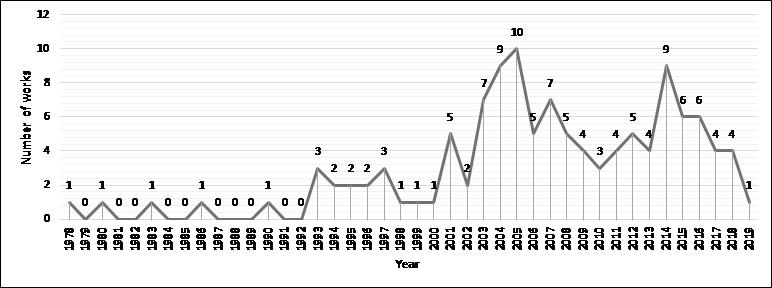
Methodologies are shown in Figure 2. Literature reviews were by far the most utilized methodology found, with n=56 works employing literature review methodology. For the purposes of this study, literature review was defined as a theoretical or conceptual work without empirical data that relied solely on other literature as its evidentiary basis. Multiple case study was the second-most popular methodology with n=28 works employing it. Following that was cross-case study (n=10). Cross-case study was defined as those works that studied over a dozen cases using data collection methods such as surveys. Historical methodology, with n=10 works, was also a relatively popular methodology. Other methodologies found were single case study (n=6), mixed case study and cross-case study (n=4), ethnography (n=2), personal account (n=2), deliberation (n=1), and historical case study (n=1).
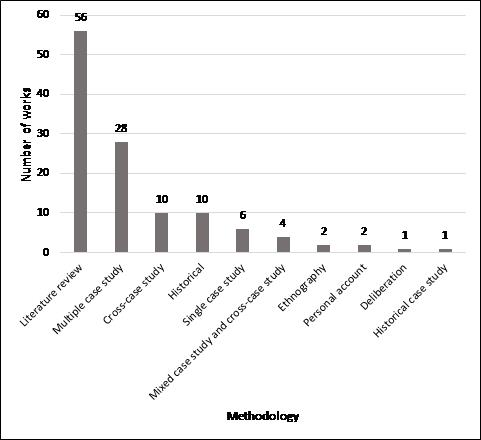
Data collection methods are shown in Figure 3. Qualitative methods were by far the most preferred data collection methods with n=106 works employing them. Mixed methods and quantitative data collection methods, each with n=7 works, were utilized relatively minimally.
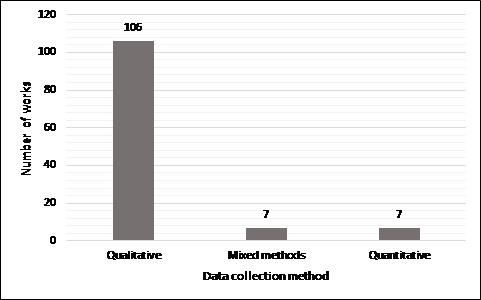
A diversity of qualitative data collection methods was used. The types of qualitative data collection methods are shown in Figure 4. Of the n=106 works that utilized qualitative data collection methods, content analysis of documents was by far the most popular with n=75 works employing them. Content analysis of documents was defined as any study reading or analysing other literature to form supporting data. The content analysis could be performed in a systematic way or not—no distinction was made here. The large number of works that used content analysis of documents as a data collection method is consistent with the large number of works that used literature review as a methodology. Other qualitative data collection methods included collecting data from interviews and documents (n=6), in-depth interviews (n=6), and interviews, observation, and documents (n=5). The number of works that used qualitative data collection methods with some element of interviewing was n=24. Interviewing was therefore a popular data collection method that was distributed amongst the works and often combined with other data collection methods, such as observation data, document data, and focus group data.
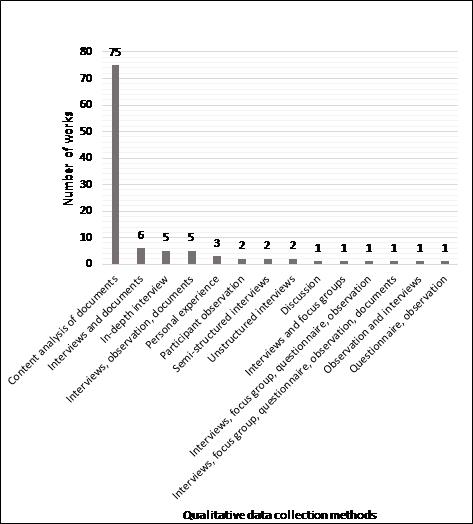
Mixed data collection methods of the works are shown in Figure 5. Mixed methods means some combination of qualitative and quantitative data collection. There were 3 types of mixed data collection methods used: interviews and survey (n=4), interviews, survey, and observations (n=2), and participant observation and questionnaire (n=1).
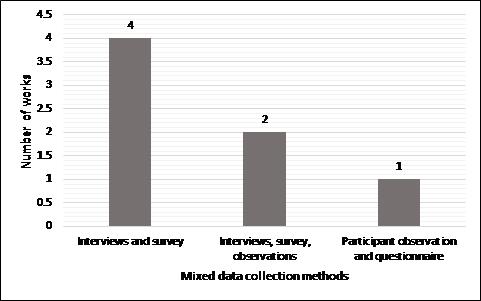
The remaining works used quantitative data collection methods. Questionnaire was the only type of quantitative method used. In the quantitative category, n=7 works used a questionnaire as a data collection method.
Data analysis methods are shown in Figure 6. The most prevalent data analysis methods were qualitative, with n=108 works employing them. Quantitative data analysis methods were employed by n=7 works, and mixed data analysis methods were used by n=5 works.
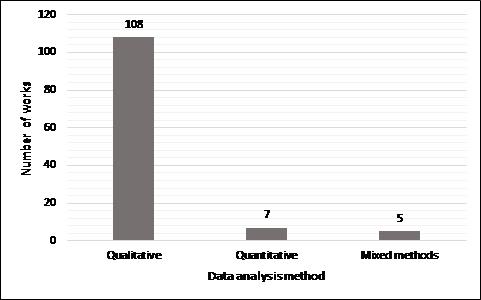
The breakdown of qualitative data analysis methods is shown in Figure 7. Five different qualitative data analysis methods were employed. The most popular type of qualitative data analysis method was description (n=65). Description means detailing what, how, who, when, or where using words. The words might be the authors’ own, or they might be drawn from interviews and documents. The next-most-used qualitative data analysis methods were theory generation (n=19), conceptual analysis (n=12), criticism (n=11), and critical discourse analysis (n=1).
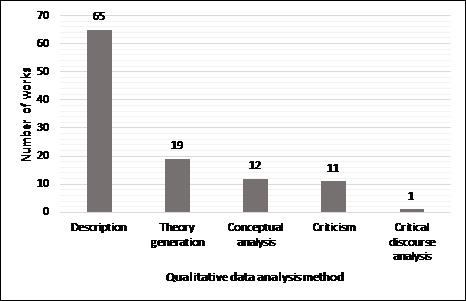
There were several more specific qualitative methods used for theory generation. These types of qualitative theory generation are shown in Figure 8. Types of theory generation included categorizing and connecting (n=11), grounded theory (n=4), and typifications and typologies (n=4).
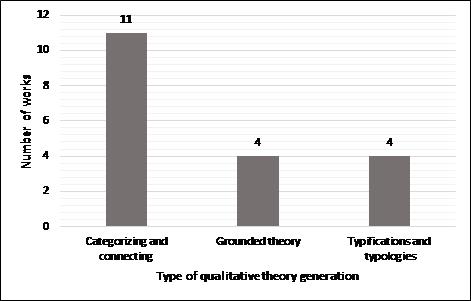
Mixed data analysis methods are shown in Figure 9. Three types of mixed data analysis methods were used: description qual and quant (n=3), multivariate regression and qualitative description (n=1), and qualitative content analysis and qualitative comparative analysis (n=1). Description qual and quant means there was some combination of descriptive statistics (numbers) and documentary evidence (words) used to present the results.
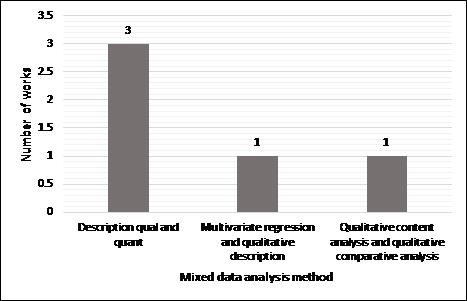
Several works used quantitative data analysis methods. In the quantitative category, n=7 works used descriptive statistics to infer results from sample to population.
The evidentiary bases are shown in Figure 10. There was a diversity of evidentiary bases used. The most popular evidentiary basis was other literature (n=57). Other literature means that the findings were based entirely on what was said by others. There was no other empirical source material used as an evidentiary basis. The next-most-popular source was documents, primary sources (n=18). This type of source material was used in histories and case studies. Next, interviews (n=9), surveys (n=7), interviews and documents (n=6), and interviews, observations, and documents (n=6) were used as evidentiary bases. Other source materials used were interviews and survey (n=4), observation and brief interviews (n=3), personal experience (n=3), observation and questionnaire (n=2), discussion (n=1), interviews and focus groups (n=1), interviews, focus groups, questionnaire, and observation (n=1), interview, focus group, questionnaire, observation, and documents (n=1), and interviews, observations, survey, and documents (n=1). Overall, interviews, documents, observations, and surveys/questionnaires were popular evidentiary bases. Interviews were used in some form in n=32 works, documents were used in some form in n=32 works, observations were used in some form in n=14 works, and surveys/questionnaires were used in some form in n=5 works.
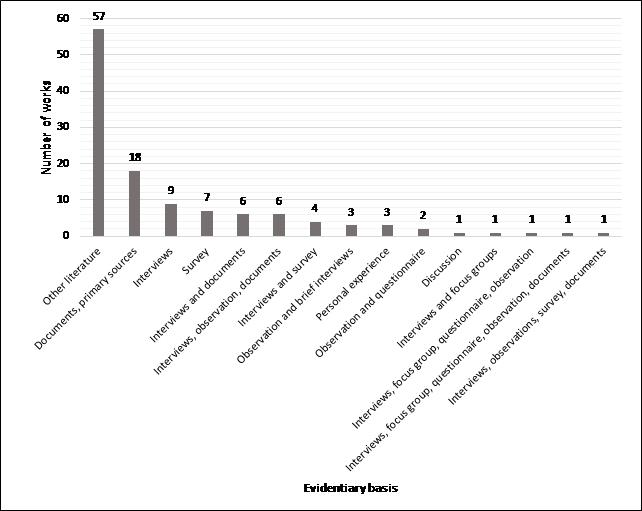
Types of resulting knowledge are shown in Figure 11. The most prevalent knowledge produced was thick description (n=53). Thick description, a term usually reserved for ethnographies, was used in this study to refer to works that used words to provide a detailed account of phenomena. The next-most-popular resulting knowledge types were concepts (n=18), normative claims (n=16), and typologies (n=10). Other types of resulting knowledges were frameworks (n=4), ideology-contradictions (n=4), theories (n=4), models (n=3), statistics and description (n=3), descriptive statistics (n=2), inferential statistics (n=2), and strategies (n=1). Ideology-contradictions means the work revealed an ideological construct and the contradictions inherent in it.
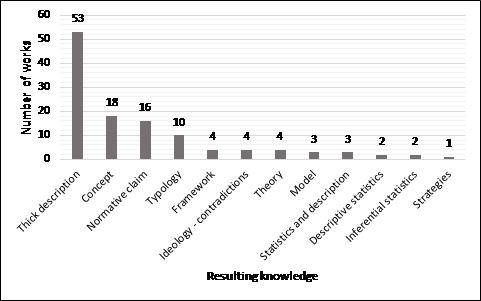
Ontologies are shown in Figure 12. According to Blaikie (2010, p. 92), ‘ontological assumptions are concerned with the nature of social reality. These assumptions make claims about what kinds of social phenomena do or can exist, the conditions of their existence, and the ways in which they are related’. There were 3 ontologies identified in the works surveyed: idealist (n=52), depth realist (n=42), and shallow realist (n=1). There was 1 work with an unknown ontology.
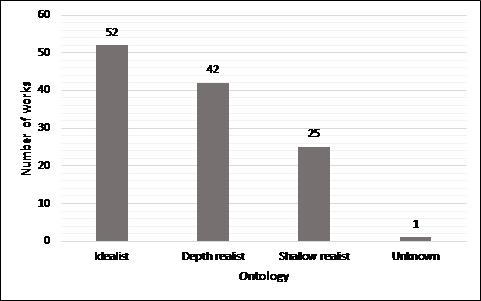
The idealist ontology is characterized by representations created by the human mind, where social reality is ‘made up of shared interpretations that social actors produce and reproduce as they go about their everyday lives’ (Blaikie, 2010, pp. 93-94). An idealist ontology was coded when a work emphasized the perspectives and interpretations of social actors, which was often done using data drawn from interviews. The prevalence of idealist ontologies coincides with the frequent use of interviews as an evidentiary basis and the frequent use of qualitative description as a data analysis method.
A depth realist ontology is characterized by a reality that is ‘stratified’. There is a domain of ‘what can be observed (empirical domain’, a domain that ‘exists independently of the observer (actual domain)’, and an ‘underlying domain of structures and mechanisms that may not be readily observed (real domain)’ (Blaikie, 2010, p. 93). Works with depth realist ontologies included those that described social norms, causal mechanisms, and social structures.
A shallow realist ontology is characterized by Blaikie (2010, p. 93) in the following way:
Phenomena we study exist independently of us; they can be observed (experienced by the senses), and only that which can be observed is relevant to science; there are patterns or sequences in observable phenomena, the challenge for science is to discover and describe them.
Indicators for shallow realist ontology included an emphasis on empirical data and data gathered through observation.
Epistemologies are shown in Figure 13. According to Blaikie (2010, p. 92), ‘epistemological assumptions are concerned with what kinds of knowledge are possible—how we can know these things—and with criteria for deciding when a particular knowledge is both adequate and legitimate’. There were 3 epistemologies identified in the works surveyed: constructionism (n=52), neo-realism (n=42), and empiricism (n=25). One work had an unknown epistemology.
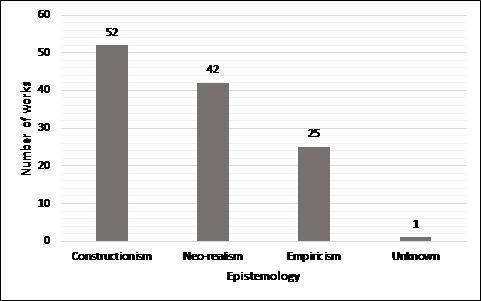
Constructionism is characterized by ‘people having to make sense of their encounters with the physical world and other people, and social scientific knowledge is the outcome of social scientists reinterpreting this everyday knowledge into technical language’ (Blaikie, 2010, p. 95). Constructionism was coded when the descriptions or other knowledge presented were based on reinterpretations of research participants’ views or perspectives.
Neo-realism emphasizes ‘knowledge of the causes of observed regularities…derived from the structures and/or mechanisms that produce them; the discovery of these structures and/or mechanisms may necessitate the postulation or selection of entitites and process that go beyond surface appearances’ (Blaikie, 2010, pp. 94-95). Neo-realism was coded for works that examined social structures or causal mechanisms.
Empiricism is characterized by knowledge that is ‘produced and verified by the use of the human senses’ (Blaikie, 2010, p. 94). Empiricism was coded when the knowledge relied on observational data and was presented as a series of facts.
Paradigms are shown in Figure 14. Blaikie (2010, p. 96) states that ‘social research is usually conducted against a background of some tradition of theoretical and methodological ideas….[research paradigms] are the source not only of theoretical ideas but also of ontological and epistemological assumptions.’ Six paradigms were identified in this survey: interpretivism (n=42), critical theory (n=28), social science realism (n=26), positivism (n=20), contemporary hermeneutics (n=2), and structuration theory (n=1). One work had no identifiable paradigm.
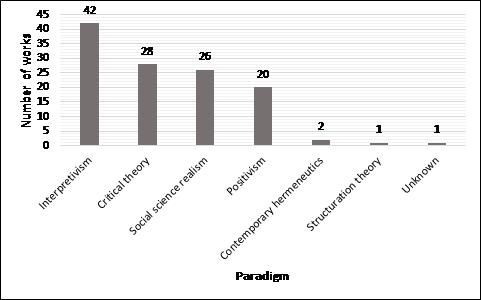
According to Blaikie (2010, p. 99), interpretivism is characterized by the following:
Social reality is regarded as the product of its inhabitants; it is a world that is interpreted by the meanings participants produce and reproduce as a necessary part of their everyday activities together…..Social regularities can be understood, perhaps explained, by constructing models of typical meanings used by typical social actors engaged in typical courses of action in typical situations.
Interpretivism was coded for works that emphasized participants’ meanings and perspectives and when knowledge was constructed based those perceptions.
Critical theory is defined by a rejection of ‘objective’ observation, as in the natural sciences, and an emphasis on emancipatory knowledge as evidenced by critical reasoning (Blaikie, 2010, p. 100). Critical theory was coded for works that used ideology critique, criticism, or conceptual analysis as data analysis techniques, when the stated objective of the study was the transformation of society, or in some instances when the resulting knowledge was a normative claim.
According to Blaikie (2010, p. 101), social science realism is defined by a reality that ‘consists not only of events that are experienced but also of events that occur whether experienced or not, and of the structures and mechanisms that produce these events. The aim of science is to discover these structures and mechanisms’. Moreover, in a social science realism paradigm, ‘The aim of science is to discover these structures and mechanisms’ using ‘hypothetical models of them’ (Blaikie, 2010, p. 101). Social science realism was coded for works that investigated social structures and causal mechanisms.
Positivism is characterized by the belief in a reality
consisting of discrete events that can be observed by the human senses. The only knowledge of this reality that is acceptable is that which is derived from experience. The language used to describe this knowledge consists of concepts that correspond to real objects, and the truth of statements in this language can be determined by observations that are uncontaminated by any theoretical notions. . It is assumed that there is order in this reality and that it can be summarized in terms of constant conjunctions between observed events and objects. These regularities, which are considered to apply across time and space, constitute general laws but not causes. Explanations are achieved by demonstrating that any regularity is a specific case of some more general law. (Blaikie, 2010, pp. 97-98)
Positivism was coded for works that emphasized knowledge regarding measureable, quantifiable, and observable events.
Contemporary hermeneutics is characterized by the interpretation of texts, where ‘different interpreters at different times are likely to produce different understandings’ (Blaikie, 2010, pp. 101-102). This paradigm was coded for works that interpreted historical texts.
Structuration theory explores the relationship between social actors (agency) and social forms or totalities (structure). The paradigm assumes that ‘social actors are engaged in both producing and reproducing their social world’, but unlike interpretivism, it acknowledges unintended consequences of actors and it emphasizes the social scientist’s standpoint (Blaikie, 2010, pp. 102-103). Structuration theory was coded for a work that analysed the dialectical relationship between libraries and society.
The results show a diversity of methodologies, methods, sources, ontologies, epistemologies, and paradigms. There is a tendency toward qualitative methods, descriptive knowledge, and a reliance on other literature as an evidentiary basis. Interviews, documents, observations, and questionnaires were used often as empirical evidentiary bases. The use of these methods and sources is consistent with the prevalence of idealist ontologies, interpretivist epistemologies, and constructionist paradigms.
What is the significance of the results for the research area? What do these results mean for research projects moving forward? Is there any way to identify a ‘golden path’ that could lead to a more focused research programme? Is it possible to identify an ideal research foundation for the public sphere and public libraries?
The results are mixed. On the one hand, the results show an impressive assortment of methods and approaches that, despite their diversity, nevertheless coalesced around a shared research interest over the past 4 decades. Only a concept as vague and abstract as the public sphere could encompass such a breadth of approaches. On the other hand, the results illustrate a research area that appears fragmented and incoherent. There does not appear to be a single research foundation suitable for transitioning the research area from a ‘pre-‘ to a ‘post-paradigm’ moment. Relatedly, the research area overall seems too free-wheeling and too much in flux to settle into a single, standard research programme.
That being said, perhaps the single-track, before/after paradigm theory proposed by Kuhn (1970) does not suit this research area. Perhaps a new conception of scientific transition is needed. What if a single research area such as this one can accommodate several parallel paradigms? What if the research foundations of these separate tracks evolve over time as the research programmes progress? Figure 15 illustrates this situation. In each track, paradigms may also be revisited as the tracks progress.
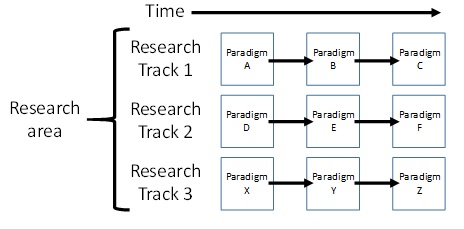
There may be no single ‘golden path’ for a research programme supported by these results, but there is at least one potentially fruitful path that uses a combination of research foundations in a specific sequence. This path begins with an idealist ontology, interpretivist epistemology, and constructionist paradigm; it then progresses to a depth realist ontology, neo-realist epistemology, and social science realist paradigm; and it evolves into a shallow realist ontology, empiricist epistemology, and positivist paradigm. Table 1 illustrates this pathway. In this pathway, the constructionist paradigm is used for exploration, the social science realist paradigm is used for synthesis, and the positivist paradigm is used for concentration on focused topics. While there is some opposition to inconsistent research foundations (Grix, 2010, p. 58), others believe foundations may be selected as appropriate (Blaikie, 2010, pp. 96-97).
| Research phase | ||||
| Exploration | Synthesis | Concentration | ||
| Research foundations | Ontology | Idealist | Depth realist | Shallow realist |
| Epistemology | Interpretivist | Neo-realist | Empiricist | |
| Paradigm | Constructionist | Social science realist | Positivist | |
In the research area related to the public sphere and public libraries, the line of research about library space illustrates this pathway. The exploratory phase began with constructionist work on the nature of space in the public library, such as by Greenhalgh, Worpole, and Landry (1995). The synthesis phase then used a social science realist paradigm to clarify and consolidate knowledge about library space, such as work by Vestheim (1997a) and Skot-Hansen (2001). This phase identified focused research directions. The concentration phase then used a positivist paradigm to follow these focused directions and build more concrete knowledge about library space, such as work by Aabø et al. (2010). This is but one example that illustrates how a combinatory approach to research foundations might lead to more focused research programmes. This sequence may continue in a cyclical way as shown in Figure 16.
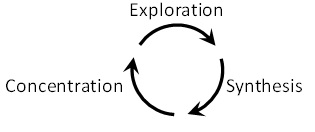
This study analysed the research foundations of the research area related to the public sphere and public libraries. The purpose of this study was to examine existing research foundations in order to make recommendations for foundations moving forward. The research design and foundations analysed included methodology, data collection method, data analysis method, evidentiary basis, resulting knowledge, ontology, epistemology, and paradigm. Results show a diversity of research designs and foundations with a tendency toward qualitative methods, interview and documentary sources, idealist ontology, interpretivist epistemology, and constructionist paradigm. While results do not indicate any single pathway toward more focused research projects, there may be potential for parallel research tracks that progress in a sequential way using constructionist, social science realist, and positivist approaches. Future work will continue to explore the trajectories of research designs and foundations over time.
Michael M. Widdersheim is assistant professor at School of Library and Information Management, Emporia State University, Kansas, US. He can be contacted at mwidders@emporia.edu
Masanori Koizumi is assistant professor in the Faculty of Library, Information and Media Science at the University of Tsukuba in Japan. He can be contacted at masanori@koizumi-labs.org
| No. | Citation | No. | Citation |
|---|---|---|---|
| 1 | [Aabø (2005)](#aab05) | 61 | [Kranich (2004)](#kra04) |
| 2 | [Aabø and Audunson (2012)](#aab12) | 62 | [Kranich (2005)](#kra05) |
| 3 | [Aabø et al. (2010)](#aab10) | 63 | [Kranich (2010)](#kra10) |
| 4 | [Alstad and Curry (2003)](#als03) | 64 | [Kranich (2013)](#kra13) |
| 5 | [Andersen (2005)](#and05) | 65 | [Larsen (2018)](#lar18) |
| 6 | [Andersen and Skouvig (2006](#and06)) | 66 | [Leckie (2004)](#lec04) |
| 7 | [R. Audunson (1996)](#aud96) | 67 | [Leckie and Buschman (2007)](#lec07) |
| 8 | [R. Audunson (1999)](#aud99) | 68 | [Leckie and Hopkins (2002)](#lec02) |
| 9 | [R. Audunson (2005a)](#aud05a) | 69 | [Ljødal (2005)](#ljo05) |
| 10 | [R. Audunson (2005b)](#aud05b) | 70 | [Machado, Elias Junior, and Achilles (2014)](#mac14) |
| 11 | [R. Audunson et al. (2017)](#aud17) | 71 | [McCabe (2001)](#mcc01) |
| 12 | [R. Audunson, Essmat, and Aabø (2011)](#aud11) | 72 | [McCook (2003)](#mcc03) |
| 13 | [R. Audunson and Evjen (2016)](#aud16) | 73 | [McCook (2004)](#mcc04) |
| 14 | [R. Audunson, Vårheim, Aabø, and Holm (2007)](#aud07) | 74 | [McNally (2014/2015)](#mcn14) |
| 15 | [R. A. Audunson et al. (2018)](#aud18) | 75 | [Newman (2007)](#new07) |
| 16 | [Beckerman (1996)](#bec96) | 76 | [Pape and Smirnova (2018)](#pap18) |
| 17 | [Bertot, Jaeger, and Hansen (2012)](#ber12) | 77 | [Richards, Wiegand, and Dalbello (2015)](#ric15) |
| 18 | [Bertot, McClure, and Jaeger (2008)](#ber08) | 78 | [Rothbauer (2007)](#rot07) |
| 19 | [Birdi, Wilson, and Mansoor (2012)](#bir12) | 79 | [Schuhböck (1983)](#sch83) |
| 20 | [Birdi, Wilson, and Tso (2009)](#bir09) | 80 | [Schuhböck (1994)](#sch94) |
| 21 | [Black and Hoare (2006)](#bla06) | 81 | [Schull (2004)](#sch04) |
| 22 | [Braman (2009)](#bra09) | 82 | [Shavit (1986)](#sha86) |
| 23 | [Burnett and Jaeger (2008)](#bur08a) | 83 | [Skot-Hansen (2001)](#sko01) |
| 24 | [Burnett and Jaeger (2011)](#bur11) | 84 | [Skot-Hansen, Hvenegaard Rasmussen, and Jochumsen (2013)](#sko13) |
| 25 | [Burnett, Jaeger, and Thompson (2008)](#bur08b) | 85 | [Skouvig (2004)](#sko04) |
| 26 | [Buschman (2003)](#bus03) | 86 | [Skouvig (2005)](#sko05) |
| 27 | [Buschman (2004)](#bus04) | 87 | [Smith and Usherwood (2003)](#smi03) |
| 28 | [Buschman (2005a)](#bus05a) | 88 | [Svendsen (2013)](#sve13) |
| 29 | [Buschman (2005b)](#bus05b) | 89 | [Taipale (2006)](#tai06) |
| 30 | [Buschman (2006)](#bus06) | 90 | [Taipale (2009)](#tai09) |
| 31 | [Buschman (2007)](#bus07) | 91 | [Thauer and Vodosek (1978)](#tha78) |
| 32 | [Buschman (2012)](#bus12) | 92 | [Trosow (2014/2015)](#tro14) |
| 33 | [Buschman (2013)](#bus13) | 93 | [Usherwood (1993)](#ush93) |
| 34 | [Caidi (2006)](#cai06) | 94 | [Usherwood (1994)](#ush94) |
| 35 | [Caidi and Allard (2005)](#cai05) | 95 | [Vakkari, Aabø, Audunson, Huysmans, and Oomes (2014)](#vak14) |
| 36 | [Cocker, Wilson, and Birdi (2008)](#coc08) | 96 | [Vårheim (2007)](#var07) |
| 37 | [Emerek (2001)](#eme01) | 97 | [Vårheim (2009)](#var09) |
| 38 | [Emerek and Ørum (1997)](#eme97) | 98 | [Vårheim (2011)](#var11) |
| 39 | [Evjen (2015)](#evj15) | 99 | [Vårheim (2014)](#var14) |
| 40 | [Frohmann (2004)](#fro04) | 100 | [Vårheim et al. (in press)](#varp) |
| 41 | [Frota (2014)](#fro14) | 101 | [Vårheim, Steinmo, and Ide (2008)](#var08) |
| 42 | [Goulding (2004)](#gou04) | 102 | [Ventura (2001)](#ven01) |
| 43 | [Greenhalgh, Landry, and Worpole (1993)](#gre93) | 103 | [Ventura (2002)](#ven02) |
| 44 | [Greenhalgh et al. (1995)](#gre95) | 104 | [Vestheim (1997a)](#ves97a) |
| 45 | [Griffis and Johnson (2014)](#gri14) | 105 | [Vestheim (1997b)](#ves97b) |
| 46 | [Hafner (1993)](#haf93) | 106 | [Webster (1995)](#web95) |
| 47 | [Hansson (2011)](#han11) | 107 | [Widdersheim (2015)](#wid15) |
| 48 | [Hart (2012)](#har12) | 108 | [Widdersheim (2016)](#wid16) |
| 49 | [Hvenegaard Rasmussen and Jochumsen (2007)](#hve07) | 109 | [Widdersheim (2018)](#wid18) |
| 50 | [Ingraham (2015)](#ing15) | 110 | [Widdersheim and Koizumi (2015a)](#wid15a) |
| 51 | [Jaeger and Burnett (2010)](#jae10) | 111 | [Widdersheim and Koizumi (2015b)](#wid15b) |
| 52 | [Jaeger, Gorham, et al. (2014)](#jae14a) | 112 | [Widdersheim and Koizumi (2016a)](#wid16a) |
| 53 | [Jaeger, Sarin, Bertot, and Gorham (2014)](#jae14b) | 113 | [Widdersheim and Koizumi (2016b)](#wid16b) |
| 54 | [Johansson (2004)](#joh04) | 114 | [Widdersheim and Koizumi (2016c)](#wid16) |
| 55 | [Johnston (2016)](#joh16) | 115 | [Widdersheim and Koizumi (2017)](#wid17) |
| 56 | [Johnston (2017)](#joh17a) | 116 | [Wiegand (2003a)](#wie03a) |
| 57 | [Johnston and Audunson (2017)](#joh17b) | 117 | [Wiegand (2003b)](#wie03b) |
| 58 | [Josey (1980)](#jos80) | 118 | [Wiegand and Bertot (2003)](#wie03) |
| 59 | [Josey and Shearer (1990)](#jos90) | 119 | [Williamson (1998)](#wil98) |
| 60 | [Kranich (2001)](#kra01) | 120 | [Williamson (2000)](#wil00) |
| Main Category | Sub-category | Sub-sub-category | Sub-sub-sub-category |
|---|---|---|---|
| 01_Methodology | Cross-case study | ||
| Deliberation | |||
| Ethnography | |||
| Historical | |||
| Historical case study | |||
| Literature review | |||
| Mixed case study and cross-case study | |||
| Multiple case study | |||
| Personal account | |||
| Single case study | |||
| 02_Methods--data collection | Mixed methods | Interviews and survey | |
| Interviews, survey, observations | |||
| Participant observation and questionnaire | |||
| Qualitative | Content analysis of documents | ||
| Discussion | |||
| In-depth interview | |||
| Interviews and documents | |||
| Interviews and focus groups | |||
| Interviews, focus group, questionnaire, observation | |||
| Interviews, focus group, questionnaire, observation, documents | |||
| Interviews, observation, documents | |||
| Observation and interviews | |||
| Participant observation | |||
| Personal experience | |||
| Questionnaire, observation | |||
| Semi-structured interviews | |||
| Unstructured interviews | |||
| Quantitative | Questionnaire | ||
| Unknown | |||
| 03_Methods--data analysis | Mixed methods | Description qual and quant | |
| Multivariate regression and qualitative description | |||
| Qualitative content analysis and qualitative comparative analysis | |||
| Qualitative | Conceptual analysis | ||
| Critical discourse analysis | |||
| Criticism | |||
| Description | |||
| Theory generation | Categorizing and connecting | ||
| Grounded theory | |||
| Typifications and typologies | |||
| Quantitative | Inferential | Sample to population | |
| 04_Evidentiary basis (sources) | Discussion | ||
| Documents, primary sources | |||
| Interviews | |||
| Interviews and documents | |||
| Interviews and focus groups | |||
| Interviews and survey | |||
| Interviews, focus group, questionnaire, observation | |||
| Interviews, focus group, questionnaire, observation, documents | |||
| Interviews, observation, documents | |||
| Interviews, observations, survey, documents | |||
| Observation and brief interviews | |||
| Observation and questionnaire | |||
| Other literature | |||
| Personal experience | |||
| Survey | |||
| 05_Resulting knowledge | Concept | ||
| Descriptive statistics | |||
| Framework | |||
| Ideology - contradictions | |||
| Inferential statistics | |||
| Model | |||
| Normative claim | |||
| Statistics and description | |||
| Strategies | |||
| Theory | |||
| Thick description | |||
| Typology | |||
| Unknown | |||
| 06_Ontology | Depth realist | ||
| Idealist | |||
| Shallow realist | |||
| Unknown | |||
| 07_Epistemology | Constructionism | ||
| Empiricism | |||
| Neo-realism | |||
| Unknown | |||
| 08_Paradigm | Contemporary hermeneutics | ||
| Critical theory | |||
| Interpretivism | |||
| Positivism | |||
| Social science realism | |||
| Structuration theory | |||
| Unknown |
| Find other papers on this subject | ||
|
|
© the authors, 2019. Last updated: 14 December, 2019 |